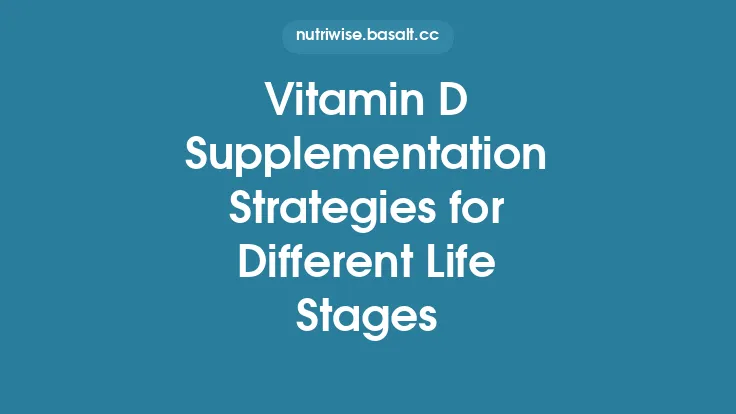Early childhood, encompassing the ages of three to five years, is a period of rapid brain growth, immune system maturation, and the establishment of lifelong dietary habits. During these formative years, micronutrients—vitamins and minerals required in small amounts—play outsized roles in shaping cognitive abilities, motor skills, bone development, and overall health. While macronutrients provide the energy needed for play and exploration, it is the micronutrients that fine‑tune the body’s biochemical pathways, support neurodevelopment, and protect against infection. Ensuring that children receive adequate amounts of these essential nutrients can set the stage for optimal learning, physical activity, and resilience against illness throughout their school years and beyond.
Key Micronutrients and Their Roles in Ages 3‑5
| Micronutrient | Primary Functions in Early Childhood | Critical Developmental Outcomes |
|---|---|---|
| Vitamin A (Retinol & Carotenoids) | Supports vision (especially low‑light), epithelial integrity, and immune function. | Clear night vision, reduced risk of respiratory and gastrointestinal infections. |
| Vitamin D (Calciferol) | Facilitates calcium and phosphorus absorption; modulates immune response. | Strong bone mineralization, prevention of rickets, optimal muscle function. |
| Vitamin E (Tocopherol) | Antioxidant protecting cell membranes; supports immune cells. | Reduced oxidative stress, enhanced immune resilience. |
| Vitamin K | Essential for blood clotting and bone metabolism. | Proper hemostasis, contribution to bone health. |
| Vitamin C (Ascorbic Acid) | Collagen synthesis, antioxidant, enhances iron absorption. | Healthy gums, skin, wound healing, improved iron status. |
| B‑Complex Vitamins (B1, B2, B3, B5, B6, B7, B9, B12) | Energy metabolism, neurotransmitter synthesis, DNA/RNA synthesis, red blood cell formation. | Cognitive development, mood regulation, growth. |
| Iron | Component of hemoglobin, myoglobin, and enzymes involved in brain neurotransmitter production. | Cognitive performance, attention span, reduced risk of anemia. |
| Zinc | Cofactor for over 300 enzymes; critical for DNA synthesis, immune function, and taste perception. | Growth velocity, wound healing, immune competence. |
| Iodine | Integral to thyroid hormone production (T3, T4). | Brain development, language acquisition, motor coordination. |
| Calcium | Bone and teeth mineralization; muscle contraction and nerve transmission. | Skeletal strength, dental health, neuromuscular coordination. |
| Magnesium | Enzyme cofactor, neuromuscular excitability, bone formation. | Sleep regulation, muscle function, bone density. |
| Selenium | Antioxidant (glutathione peroxidase), thyroid hormone metabolism. | Immune defense, protection against oxidative damage. |
| Copper | Iron metabolism, connective tissue formation, neurodevelopment. | Hemoglobin synthesis, brain development. |
| Manganese | Enzyme activation for carbohydrate, amino acid, and cholesterol metabolism. | Bone formation, antioxidant defenses. |
Recommended Dietary Allowances (RDAs) for Ages 3‑5
| Micronutrient | RDA (per day) | Upper Intake Level (UL) |
|---|---|---|
| Vitamin A (RAE) | 300 µg | 600 µg |
| Vitamin D | 600 IU (15 µg) | 2,500 IU (62.5 µg) |
| Vitamin E | 7 mg (α‑tocopherol) | 200 mg |
| Vitamin K | 55 µg | No established UL |
| Vitamin C | 25 mg | 400 mg |
| Thiamin (B1) | 0.5 mg | 10 mg |
| Riboflavin (B2) | 0.5 mg | 10 mg |
| Niacin (B3) | 6 mg NE | 20 mg |
| Pantothenic Acid (B5) | 2 mg | No UL |
| Vitamin B6 | 0.5 mg | 30 mg |
| Biotin (B7) | 8 µg | No UL |
| Folate (B9) | 150 µg DFE | 300 µg |
| Vitamin B12 | 1.2 µg | No UL |
| Iron | 7 mg | 40 mg |
| Zinc | 5 mg | 12 mg |
| Iodine | 90 µg | 200 µg |
| Calcium | 1,000 mg | 2,500 mg |
| Magnesium | 130 mg | 350 mg |
| Selenium | 20 µg | 90 µg |
| Copper | 0.34 mg | 1 mg |
| Manganese | 1.5 mg | 6 mg |
*Note: RDAs are derived from the Institute of Medicine (now the National Academy of Medicine) and reflect average daily intake levels sufficient to meet the nutrient requirements of nearly all (97‑98 %) healthy children in this age group.*
Food Sources Rich in Essential Micronutrients
| Micronutrient | Top Food Sources (portion size for a 4‑year‑old) |
|---|---|
| Vitamin A | ½ cup cooked sweet potatoes, ¼ cup pureed carrots, ½ cup fortified milk |
| Vitamin D | ½ cup fortified orange juice, 1 cup fortified soy milk, 2 oz salmon |
| Vitamin E | ¼ cup sunflower seeds, ½ avocado, 1 tbsp wheat germ oil |
| Vitamin K | ½ cup cooked kale, ¼ cup peas, 1 tbsp olive oil (fat enhances absorption) |
| Vitamin C | ½ cup orange segments, ¼ cup strawberries, ½ cup bell pepper strips |
| B‑Complex | Whole grain cereals, ½ cup lentils, 1 egg, ½ cup yogurt |
| Iron | ½ cup cooked lentils, 1 oz lean beef, ¼ cup fortified cereal |
| Zinc | ½ cup cooked chickpeas, 1 oz cheese, ¼ cup pumpkin seeds |
| Iodine | 1 tsp iodized salt (used in cooking), ½ cup dairy, 1 oz seaweed snack (if culturally appropriate) |
| Calcium | ½ cup fortified milk, ¼ cup low‑fat cheese, ½ cup broccoli |
| Magnesium | ¼ cup almonds, ½ cup black beans, ½ cup whole‑grain toast |
| Selenium | 1 oz Brazil nuts (very high; limit to 1‑2 per week), ½ cup brown rice |
| Copper | ¼ cup cashews, ½ cup lentils, 1 oz liver (occasionally) |
| Manganese | ½ cup oatmeal, ¼ cup pineapple, ½ cup brown rice |
Practical tip: Pair fat‑soluble vitamins (A, D, E, K) with a small amount of healthy fat (e.g., olive oil, avocado) to improve absorption. For iron, combine with vitamin C‑rich foods to enhance non‑heme iron uptake.
Common Deficiencies and Signs to Watch For
| Micronutrient | Early Signs of Deficiency | Potential Long‑Term Consequences |
|---|---|---|
| Iron | Pale skin, fatigue, irritability, reduced attention span | Anemia, impaired cognitive development, delayed motor skills |
| Vitamin D | Bone pain, delayed tooth eruption, frequent fractures | Rickets, compromised bone density, increased infection risk |
| Iodine | Goiter (enlarged thyroid), slowed growth, speech delays | Reduced IQ, learning difficulties |
| Zinc | Poor wound healing, frequent colds, taste alterations | Stunted growth, impaired immune response |
| Vitamin A | Night blindness, dry skin, recurrent infections | Vision problems, increased morbidity |
| Calcium | Muscle cramps, poor dentition | Osteopenia, increased fracture risk later in life |
| B‑Vitamins (esp. B12, Folate) | Glossitis, irritability, developmental delays | Megaloblastic anemia, neurodevelopmental deficits |
Because many deficiencies develop subtly, routine pediatric check‑ups that include growth measurements and, when indicated, laboratory screening (e.g., hemoglobin, serum ferritin, 25‑OH vitamin D) are essential.
Strategies to Ensure Adequate Intake
- Balanced Plate Approach
- Half the plate: colorful fruits and vegetables (vitamins A, C, K, folate).
- Quarter: lean proteins or legumes (iron, zinc, B‑vitamins).
- Quarter: whole grains or dairy (calcium, magnesium, B‑vitamins).
- Fortified Foods
- Use fortified cereals, milks, and plant‑based alternatives to bridge gaps, especially for vitamin D and iron.
- Snack Smart
- Offer nutrient‑dense snacks such as hummus with carrot sticks, cheese cubes with whole‑grain crackers, or yogurt with berries.
- Limit Empty‑Calorie Foods
- Reduce sugary beverages and highly processed snacks that displace nutrient‑rich options.
- Cultural and Preference Sensitivity
- Incorporate traditional foods (e.g., lentil dal, tofu, millet) that naturally contain target micronutrients.
- Supplementation When Needed
- Only after professional assessment; common supplements include vitamin D drops (especially in low‑sunlight regions) and iron drops for documented deficiency.
Special Considerations
Picky Eaters
- Repeated Exposure: Offer a new vegetable up to 10–15 times before assuming rejection.
- Creative Presentation: Use cookie‑cutters for fruit shapes, blend vegetables into sauces or smoothies, or create “food art.”
- Modeling: Eat the same foods alongside the child; children mimic adult behavior.
Dietary Restrictions
- Vegetarian/Vegan: Emphasize legumes, fortified plant milks, tofu, nuts, seeds, and consider a vitamin B12 supplement.
- Gluten‑Free: Use naturally gluten‑free whole grains (quinoa, rice, buckwheat) and ensure they are fortified with iron and B‑vitamins.
- Allergies (e.g., dairy, nuts): Substitute with calcium‑fortified soy or oat milks, and use seed‑based spreads for zinc and vitamin E.
Low‑Sunlight Environments
- Prioritize vitamin D‑rich foods and consider a daily supplement of 400–600 IU, as recommended by pediatric guidelines for children with limited sun exposure.
Monitoring and Assessment
| Assessment Tool | Frequency | What It Evaluates |
|---|---|---|
| Growth Charts (height, weight, BMI) | Every 3–6 months | Overall nutritional status, indirect indicator of micronutrient adequacy |
| Dietary Recall (24‑hour or 3‑day) | Annually or during well‑child visits | Identify gaps in food groups and micronutrient sources |
| Laboratory Tests | As indicated (e.g., anemia symptoms) | Serum ferritin, hemoglobin, 25‑OH vitamin D, thyroid‑stimulating hormone (TSH) for iodine status |
| Developmental Screening | At 3‑year and 5‑year well‑child visits | Cognitive, language, and motor milestones that can be impacted by micronutrient deficiencies |
When deficiencies are identified, a multidisciplinary approach—pediatrician, dietitian, and caregiver—ensures tailored dietary modifications and, if necessary, therapeutic supplementation.
Practical Meal‑Planning Tips for Busy Families
- Batch‑Cook and Freeze
- Prepare large pots of iron‑rich lentil soup or chicken stew; portion into child‑size containers for quick reheating.
- One‑Pot Meals
- Combine whole grains, beans, and vegetables in a single skillet; add a splash of fortified broth for extra calcium and vitamin D.
- Smoothie Power
- Blend spinach (vitamin A, K), banana, fortified milk, and a spoonful of nut butter for calcium, magnesium, and zinc.
- “Build‑Your‑Own” Stations
- Set out a taco bar with corn tortillas, shredded cheese, black beans, diced tomatoes, and avocado; children can assemble their own meals, increasing exposure to varied nutrients.
- Utilize the “Rainbow” Rule
- Aim for at least three different colored fruits/vegetables per day to naturally cover a broad spectrum of vitamins and minerals.
- Smart Grocery Lists
- Include a mix of fresh, frozen, and canned (low‑sodium, no added sugar) produce to ensure year‑round availability of nutrient‑dense foods.
Closing Thoughts
The ages of three to five represent a window of opportunity where the brain’s architecture is highly plastic, the immune system is solidifying, and skeletal growth accelerates. By delivering a balanced array of essential micronutrients—through diverse, appealing foods and, when necessary, targeted supplementation—caregivers can lay a robust foundation for lifelong health, learning, and well‑being. Regular monitoring, culturally sensitive meal planning, and proactive strategies to overcome picky eating or dietary restrictions empower families to meet these nutritional goals and nurture the next generation of thriving, curious, and resilient children.





